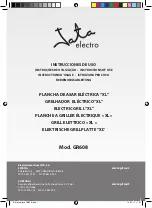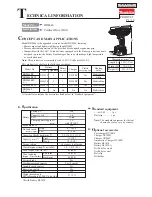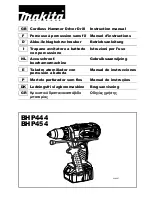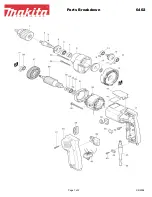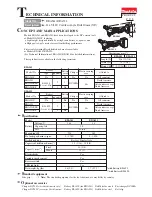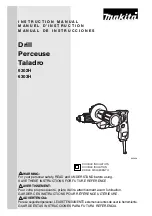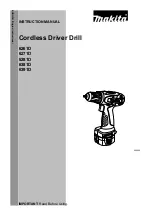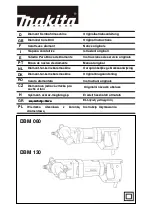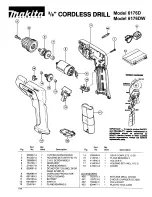
19
19
or smoke in the work area.
■
Damage to hearing – Always wear effective hearing protection
and limit exposure to noise.
■
Damage to eyes from flying dust and debris particles – Always
wear suitable eye protection.
■
Injury caused by vibration – Hold the product by designated
handles; limit exposure to vibration. See “risk reduction”.
RISK REDUCTION
It has been reported that vibrations from handheld tools may
contribute to a condition called Raynaud’s Syndrome in certain
individuals. Symptoms may include tingling, numbness and blanching
of the fingers, usually apparent upon exposure to cold. Hereditary
factors, exposure to cold and dampness, diet, smoking and work
practices are all thought to contribute to the development of these
symptoms. There are measures that can be taken by the operator to
possibly reduce the effects of vibration:
■
Keep your body warm in cold weather. When operating the unit
wear gloves to keep the hands and wrists warm. It is reported
that cold weather is a major factor contributing to Raynaud’s
Syndrome.
■
After each period of operation, exercise to increase blood
circulation.
■
Take frequent work breaks. Limit the amount of exposure per day.
If you experience any of the symptoms of this condition, immediately
discontinue use and see your doctor about these symptoms.
WARNING!
Injuries may be caused or aggravated by prolonged
use of a tool. When using any tool for prolonged periods, ensure you
take regular breaks.
SPECIFIED CONDITIONS OF USE
This electronic percussion drill/screwdriver is intended to be used
only by adults who have read and understood the instructions and
warnings in this manual and can be considered responsible for their
actions.
The product can be used for drilling into various materials including
wood, metal and plastics using a drill bit less than 13 mm in diameter.
The product can also be used in hammer mode for drilling masonry
and similar materials.
Do not use the product for any other purpose not described above.
BATTERIES
Battery packs which have not been used for some time should be
recharged before use.
Temperatures in excess of 50°C (122°F) reduce the performance of
the battery pack. Avoid extended exposure to heat or sunshine (risk
of overheating).
The contacts of chargers and battery packs must be kept clean.
For an optimum life-time, the battery packs have to be fully charged,
after used.
To obtain the longest possible battery life remove the battery pack
from the charger once it is fully charged.
For battery pack storage longer than 30 days:
• Store the battery pack where the temperature is below 27°C and
away from moisture.
• Store the battery packs in a 30% - 50% charged condition.
• Every six months of storage, charge the pack as normal.
ADDITIONAL BATTERY SAFETY WARNINGS
WARNING!
To reduce the risk of fire, personal injury, and product
damage due to a short circuit, never immerse your tool, battery pack
or charger in fluid or allow a fluid to flow inside them. Corrosive or
conductive fluids, such as seawater, certain industrial chemicals, and
bleach or bleach containing products, etc., can cause a short circuit.
Ambient temperature range for battery during use is between 0°C
and 40°C.
Ambient temperature range for battery storage is between 0°C and
27°C.
TRANSPORTING LITHIUM BATTERIES
Lithium-ion batteries are subject to the Dangerous Goods Legislation
requirements.
Transportation of those batteries has to be done in accordance with
local, national and international provisions and regulations.
■
The user can transport the batteries by road without further
requirements.
■
Commercial transport of Lithium-Ion batteries by third parties is
subject to Dangerous Goods regulations. Transport preparation
and transport are exclusively to be carried out by appropriately.
trained persons and the process has to be accompanied by
corresponding experts.
When transporting batteries:
■
Ensure that battery contact terminals are protected and insulated
to prevent short circuit.
■
Ensure that battery pack is secured against movement within
packaging.
■
Do not transport batteries that are cracked or leak.
Check with forwarding company for further advice.
BATTERY PACK PROTECTION
The battery pack has overload protection that protects it from being
overloaded and helps to ensure long life. Under extreme stress the
battery electronics switch off the product automatically. To restart,
switch the product off and then on again. If the product does not start
up again, the battery pack may have discharged completely. In this
case it must be recharged in the battery charger.
MAINTENANCE
The ventilation slots of the product must be kept clear at all times.
Use only AEG accessories and AEG spare parts. Should components
need to be replaced which have not been described, please contact
one of our AEG service agents (see our list of guarantee/service
addresses).
If needed, an exploded view of the tool can be ordered. Please state
the Article No. as well as the product type printed on the label and
order the drawing at your local service agents or directly at:
WARNING!
Avoid using solvents when cleaning plastic parts.
Most plastics are susceptible to damage from various types of
commercial solvents and may be damaged by their use. Use clean
cloths to remove dirt, dust, oil, grease, etc.
WARNING!
Do not at any time let brake fluids, gasoline,
Содержание A18PDB
Страница 1: ...A18PDB Original instructions ...
Страница 4: ...4 4 2 8 11 6 9 14 ...
Страница 5: ...5 5 3 10 16 12 16 START STOP 13 ...
Страница 6: ...6 6 6 1 2 2 1 click Remove the battery pack before starting any work on the machine ...
Страница 7: ...7 7 78 100 33 54 55 77 10 32 10 ...
Страница 8: ...8 8 8 1 2 1 2 ...
Страница 9: ...9 9 7 1 2 ...
Страница 10: ...10 10 8 START STOP ...
Страница 11: ...11 11 11 ...
Страница 12: ...12 12 LOCK ...
Страница 13: ...13 13 ...
Страница 14: ...14 14 2 22 4 ...
Страница 15: ...15 15 ...
Страница 21: ......
Страница 22: ......
Страница 23: ......





















